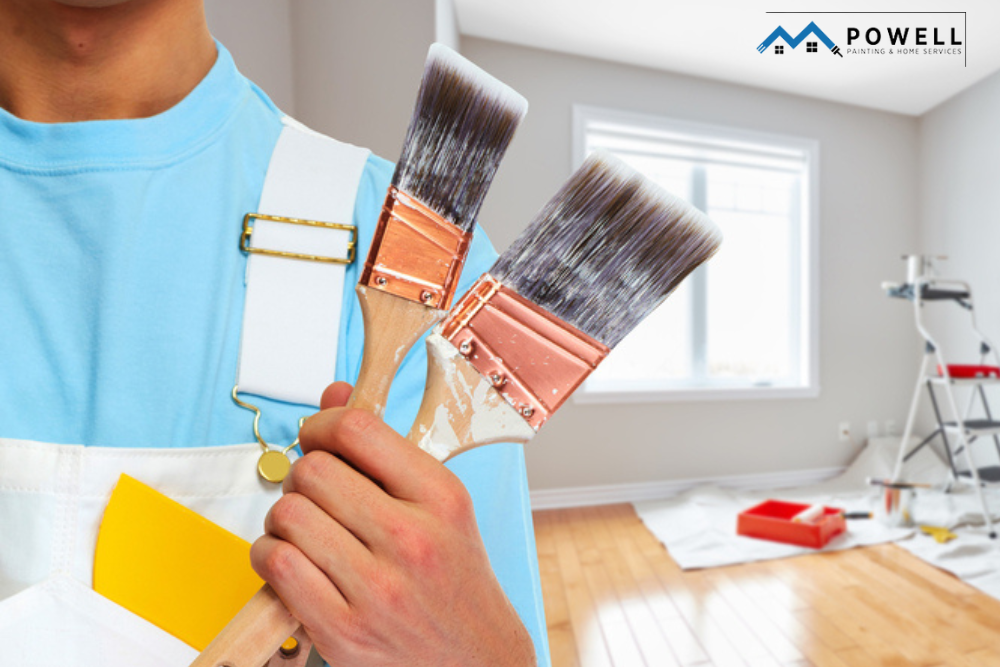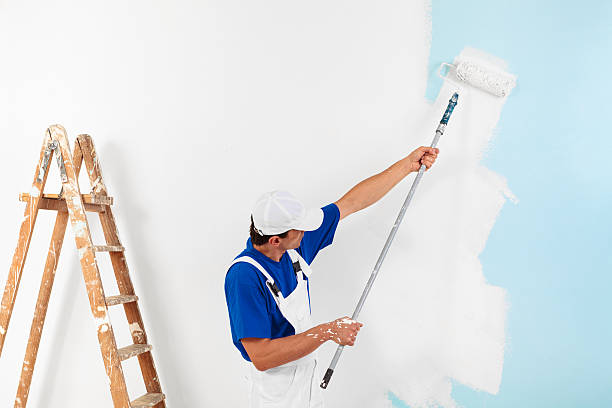Design Beautiful Interiors with expert Help from paint shops in corpus christi
Discovering the Different Kinds Of Paint: A Guide for each Project
Discovering the different kinds of paint is essential for achieving the desired result in any kind of job. From water-based alternatives that provide comfort to oil-based paints understood for their longevity, each selection has its values. Specialized paints can include one-of-a-kind structures or finishes, while green alternatives satisfy those seeking sustainability. Comprehending these differences can substantially influence the success of a painting endeavor. What elements should one take into consideration when making the ideal selection?
Recognizing Paint Kinds: Oil-Based vs. water-based
Paint types can noticeably affect a project's end result, and comprehending the differences in between water-based and oil-based paints is crucial for notified decision-making. Water-based paints, commonly referred to as latex paints, are made up of water as the key solvent. They dry promptly, give off less unstable natural substances (VOCs), and are very easy to cleanse up with soap and water. This makes them a prominent option for indoor applications and environments where air quality is a problem.
On the other hand, oil-based paints make use of organic solvents, offering a durable, glossy finish suitable for surface areas exposed to tear and use, such as trim and cabinets. They take longer to dry, call for mineral spirits for cleaning, and have a more powerful smell. corpus christi paint store. Choosing between these 2 kinds relies on the particular requirements of the job, considering factors such as desired finish, application atmosphere, and simplicity of maintenance. Each kind has distinctive advantages and constraints, assisting the choice procedure
The End Up Matters: Choosing In Between Matte, Satin, and Gloss
When picking a paint surface, the selection between matte and glossy options significantly influences both aesthetic appeals and performance. Matte finishes offer a subtle, non-reflective appearance that can hide surface imperfections, while glossy finishes supply longevity and ease of cleansing. Understanding the benefits and considerations of each can aid in making a notified decision for any painting task.
Matte Finish Advantages
Although numerous house owners dispute the merits of different finishes, matte paint supplies distinct benefits that make it a preferred option for both indoor and exterior applications. One of the primary advantages of matte coating is its capacity to hide surface area imperfections, developing a smoother look on wall surfaces. This high quality is particularly beneficial in older homes or areas with irregular surface areas. In addition, matte paint soaks up light rather than mirroring it, which can boost the aesthetic of a space by giving a more sophisticated and soft look. Matte finishes are usually easier to touch up than glossier alternatives, as they can mix much more seamlessly when used over existing paint. Generally, matte paint is a superb selection for those looking for a fine-tuned and sophisticated coating.
Shiny Complete Factors To Consider
A shiny coating can substantially modify the understanding of a room, providing a smooth and reflective quality that enhances both shade vibrancy and light within a space. This surface is often preferred for high-traffic areas and surface areas like cooking areas and bathrooms, where toughness and convenience of cleansing are vital. Its reflective nature can highlight blemishes on walls, making correct surface prep work essential. Shiny paints likewise have a tendency to show smudges and fingerprints quicker, requiring regular upkeep. Furthermore, illumination plays a significant role; in bright atmospheres, a shiny coating may create glow, impacting the overall aesthetic. As a result, cautious factor to consider of the particular application and atmosphere is very important when picking a shiny finish for any type of project.
Specialty Paints: When to Utilize Distinctive or Chalk Paint
Specialty paints, such as textured and chalk paint, deal unique aesthetic and useful advantages that can enhance various surface areas. Textured paint is perfect for creating depth and measurement on wall surfaces, concealing imperfections while including a three-dimensional feel. It is especially useful in high-traffic locations where longevity and visual rate of interest are important.

Both kinds of specialty paints can transform rooms, however picking the right one depends on the preferred impact and surface area requirements. Textured paint might suit larger locations, while chalk paint can renew smaller sized things, showcasing imagination and individual style in any kind of job.
Outside Paints: Securing Your Surface Areas From the Elements
Exterior paints are essential for safeguarding surfaces versus numerous climate condition. Recognizing their climate resistance functions, appropriate surface area preparation requirements, and efficient application methods can greatly improve sturdiness and performance. This area will detail crucial factors to consider for selecting and making use of outdoor paints effectively.
Weather Condition Resistance Features
Weather condition resistance is an essential feature of outside paints, as it identifies exactly how well surface areas can endure the rough aspects of nature. High-grade outdoor paints are formulated to stand up to damages from UV rays, moisture, and temperature level fluctuations. UV resistance warranties colors remain vibrant gradually, stopping fading and discoloration. Moisture resistance shields versus mold and mold, which can compromise the integrity of surface areas. In addition, paints with excellent temperature level resistance can expand and get without cracking, keeping their protective high qualities. When picking exterior paints, it is essential to take into account these weather resistance features, as they add to the long life and toughness of colored surface areas, ensuring they stay cosmetically pleasing and functional in spite of direct exposure to the components.
Surface Preparation Demands
Appropriate surface preparation is an essential action in attaining the very best results with exterior paints. To assure suitable attachment and sturdiness, surfaces need to be thoroughly cleansed, eliminating mold, grease, and dirt. This can be achieved making use of a stress washing machine or a scrub brush with a suitable cleaning remedy. As soon as cleaned up, surfaces should be examined for any type of peeling or flaking paint, which have to be scratched away to create a smooth foundation. Fixing any holes or fractures is additionally important, as these can enable wetness seepage. Additionally, fining sand harsh areas advertises better paint bond. Lastly, using a primer matched for outdoor use can improve the paint's efficiency, guaranteeing a long-lasting finish that stands up to the aspects. Proper prep work is key to a successful exterior painting project.
Application Methods Tips
While using exterior paints, it is important to make use of reliable strategies that guarantee surfaces are well-protected versus the elements. Choose the ideal day for painting; low moisture and light temperature levels improve attachment and drying out. Prepping the surface area completely-- cleansing, sanding, and priming-- makes sure far better paint bond and durability. Using top notch brushes or rollers can offer a smoother surface, while spray painting might cover huge areas successfully. Applying paint in thin, also layers stops runs and drips. It is suggested to follow maker directions pertaining to drying out times in between coats. Finally, verify proper air flow throughout application to facilitate drying and lessen exposure to fumes. These strategies greatly improve the durability and effectiveness of exterior paint.
Eco-Friendly Options: Low-VOC and Zero-VOC Paints
As consumers come to be progressively familiar with the environmental influence of their selections, zero-voc and low-voc paints have emerged as prominent options. These paints are created to have fewer unpredictable organic substances (VOCs), which are chemicals that can evaporate right into the air and add to air contamination and health issue. Low-VOC paints generally contain a minimal amount of VOCs, while zero-VOC paints have negligible levels, making them more secure for both exterior and indoor usage.
The advantages of utilizing low-VOC and zero-VOC paints extend past environmental considerations; they likewise improve indoor air high quality, lowering the risk of sensitive reactions and breathing problems. Many makers currently supply a variety of shades and finishes in environment-friendly choices, making it easier for consumers to find suitable items for their tasks. By choosing these paints, individuals can add to a healthier environment while still accomplishing the visual they desire in their spaces.
Tools and Techniques for a Remarkable Application
Accomplishing a perfect paint application requires the right tools and strategies, which can considerably boost the outcome. Picking the proper brush or roller is necessary; brushes work well for edges and complex areas, while rollers cover larger surfaces effectively. Utilizing premium products guarantees much better paint distribution and decreases streaks. For perfect results, surface preparation is imperative. This consists of cleansing, fining sand, and priming surfaces to advertise bond.
Strategy additionally plays a significant function. The "W" approach with a roller assists to evenly distribute paint, while long, smooth strokes with a brush protect against noticeable lines. Functioning in areas enables better control and mixing. In addition, applying thin coats is more suitable to thick layers, lowering the threat of drips and uneven structures. Preserving a damp edge during application assists achieve smooth changes in between locations. By integrating these tools and methods, one can attain a specialist and polished surface.
Tips for Preserving and Taking Care Of Your Painted Surfaces
Proper maintenance and care of coloured surface areas can significantly expand their lifespan and maintain their look. Routine cleaning is essential; making use of a soft cloth or sponge with moderate soap and water can eliminate dirt and dirt without damaging the paint. It is recommended to stay clear of rough cleansers or scrubbing pads, as these can scrape the surface. In addition, using a fresh layer of paint every few years can invigorate the shade and protect versus wear.
For outside surface areas, examining for indications of peeling off or fading consistently is very important. Immediately attending to any concerns avoids more damage. In areas susceptible to wetness, such as shower rooms, using mold-resistant paint and ensuring correct ventilation can help preserve the integrity of the paint. Using safety surfaces can protect versus UV rays and discolorations, guaranteeing that repainted surface areas remain appealing and dynamic for years to come, eventually boosting the general aesthetic of the space.

Often Asked Questions
Can I Mix Different Kind Of Paint Together?
Mixing different here sorts of paint is normally not advised, as it can bring about issues like inadequate attachment, irregular appearance, or unforeseen chemical responses. It's finest to make use of compatible paints for ideal outcomes and durability.

Exactly how Do I Correctly Shop Leftover Paint?
To properly keep remaining paint, seal the container firmly, label it with the day and color, and maintain it in a trendy, dry area away from straight sunshine and severe temperature levels for perfect preservation.
What Is the Best Way to Deal With Unused Paint?
The most effective means to get rid of extra paint is to inspect local laws, as several locations have assigned dangerous waste facilities. Alternatively, consider donating usable paint to area organizations or institutions for their tasks.
Just How Can I Tell if Paint Is Still Excellent to Use?
To establish if paint is still excellent, analyze its consistency, smell, and shade. If it appears apart, has an unpleasant smell, or reveals considerable adjustments in structure, it's most likely no more useful.
Exist Age Restrictions for Purchasing Paint Products?
In lots of regions, there are no details age constraints for purchasing paint items. Some shops might need customers to be at the very least 18 years old, specifically for items containing solvents or hazardous products.
Paint types can considerably affect a task's result, and understanding the differences between water-based and oil-based paints is essential for notified decision-making. Water-based paints, typically referred to as latex paints, are composed of water as the key solvent. In comparison, oil-based paints use organic solvents, supplying a sturdy, shiny coating ideal for surface areas subjected to tear and put on, such as trim and cupboards. Specialty paints, such as textured and chalk paint, offer one-of-a-kind aesthetic and sensible advantages that can enhance various surfaces. In areas prone to wetness, such as bathrooms, using mold-resistant paint and making sure correct air flow can assist preserve the honesty of the paint.